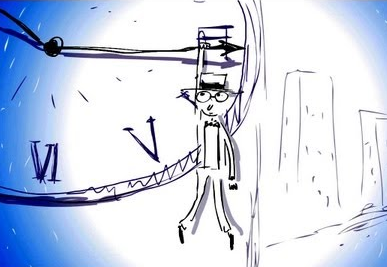(单词翻译:单击)
We check the time every day, all day long.
我们每天都在核对时间,基本上一整天都在核对。
But did you ever wonder - where did telling time come from?
但你有没有想过,报时这档事是从哪儿来的?
Why does it matter what time it is?
为什么知道时间是那么重要呢?
Who determined the clock and why in the world are there so many different time zones?
时间是由谁定的?为什么世界上有这么多不同的时区?
The first form of telling time was the sundial
第一种观察时间的方式是透过日晷
and the earliest sundials known from the archaeological record are obelisks from nearly 5,000 years ago.
根据考古记录我们得知,最早的日晷就是五千年前的方尖碑。
Sundials indicate the time by casting a shadow onto a surface.
日晷透过投射于地面上的阴影,指出当下的时刻。
The object that casts the shadow is a stick in the center known as a gnomon.
投射阴影的对象是一根被称为日晷的棍子。
A well-constructed sundial can measure time with remarkable accuracy,
制作一个完好的日晷可以让我们准确地测量时间,
and sundials were used to monitor the performance of clocks until the modern era.
到现代来临前,日晷一直被人们拿来检测时钟的性能。
But sundials have their limitations too.
但日晷也有其局限。
Obviously they require the sun to shine, so they don't work at all during the night when it's dark.
显然地,它们需要阳光,因此它们在漆黑的夜晚中无法工作。
Many different devices have been used over the years to estimate the passage of time:
人们在许多年中使用了多种不同的设备来测量时间的推移:
candles and sticks of incense that burn down at fairly predictable speeds have been used, along with the hourglass.
蜡烛、熏香枝和沙漏,以一种可预测的速度燃烧,人们用它们来测量时间。
Hourglasses are devices in which fine sand pours through a tiny hole at a constant rate
沙漏是一种以细沙流淌过一个小洞的设备,人们用它的恒定速率来测量时间
and indicates a predetermined passage of an arbitrary period of time.
它指出细沙在一段时间中所流动的速率。

The origin of the hourglass is uncertain,
我们不确定沙漏的起源为何,
although beginning in the 14th century, the hourglass was used commonly, especially on board ships.
虽然自十四世纪开始人们已经开始普遍地使用沙漏,特别是用在船上。
The motion of the boat on the water did not affect the hourglass, unlike other time-measuring devices.
不同于其它测量时间的装置,船在水上的晃动并不会影响沙漏。
The mechanical clock was invented in the 13th century which sparked a big change in traditional timekeeping methods.
十三世纪时,有人发明了机械时钟,这个装置引发了传统计时方法的大变化。
This modern clock relied on the swing of a pendulum or the vibration of a quartz crystal, which was far more accurate than sand or candles.
这个现代时钟仰赖一个钟摆,或一个振动石英晶体的摆动而运作,它的准确率远远超过沙漏或蜡烛
Today, the basis for scientific time is a continuous count of seconds based on atomic clocks all around the world,
今天,科学的时间是基于一串根据世上所有原子时钟所连续运行的读秒,
known as the international atomic time.
它被称为国际原子时间。
Why does it matter that we keep track of time?
为什么记住时间很重要呢?
Well, time regulates our daily lives and makes it possible to accurately communicate with people all over the world.
嗯,时间让我们可以调整日常生活,让我们能够准确地与世上所有人沟通。
Without a time system, we would have many challenges in farming, social structures, communication, and business.
如果没有时间系统,我们可能会在农耕、社会结构、通信和商业等层面上面临许多挑战。
Take the American railroad system, for example.
以美国的铁路系统为例。
In the mid-19th century, each railroad used its own standard time generally based on the local time of its headquarters,
十九世纪中期,每条铁路使用它自己的标准时间,它们通常是以其总部的本地时间为准。
and the railroad's train schedules were published using its own time.
铁路公司用它自己的时间发布自己的火车时刻表。
Some major railroad junctions served by several different railroads had a separate clock for each railroad, each showing a different time.
有一些主要的铁路交汇口由几条不同的铁路交错而过,每一条铁路有各自不同的时钟。每个时钟都显示了不同的时刻。
The distance between New York and Boston is about 2 degrees, or 8 minutes,
纽约和波士顿之间的距离大约有两度,或八分钟,
which can be the difference between making or missing your train connection.
这个小差距可以成为你赶上或者错过班车的关键
If the difference between New York and Boston is 8 minutes, imagine the difference between Boston and Australia.
如果纽约和波士顿之间的时差是八分钟,你可以想象波士顿与澳大利亚之间的差距该有多少呢?
The use of time zones irons out these differences and makes communication significantly smoother.
时区消除了这些差异,让沟通变得更流畅。
A time zone is a region on earth that has a uniform standard time.
时区是地球上的一个统一了标准时间的区域。
There are 40 time zones on land because the earliest and latest time zones are 26 hours apart.
因为地球上最早和最晚的时区相距了二十六个小时,所以我们有四十个时区。
Any given calendar date exists at some point on the globe for 50 hours.
所有日历的日期,在地球上都将存在50个小时。
So the next time someone asks you 'What time is it?'
所以下次有人问你:现在是几点?
Your answer may be a whole lot more complicated than it used to be.
你的回答也许会比之前的更加复杂也说不定呢。


